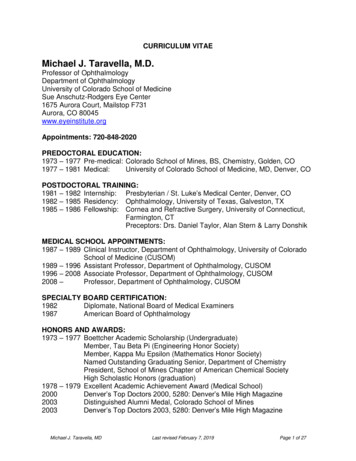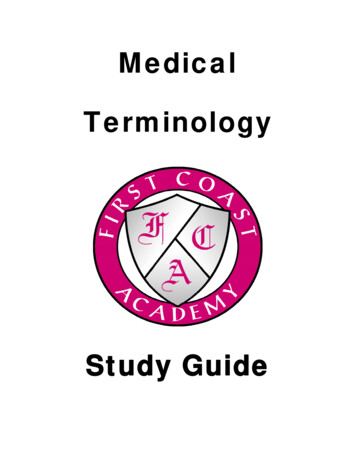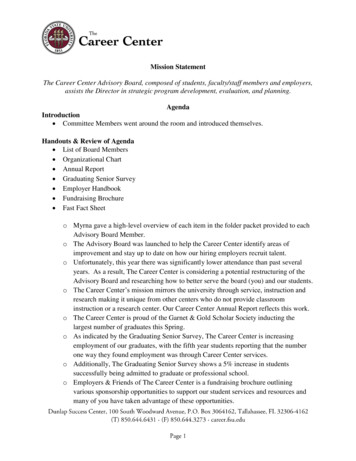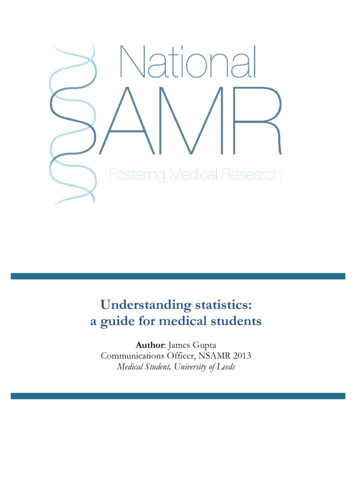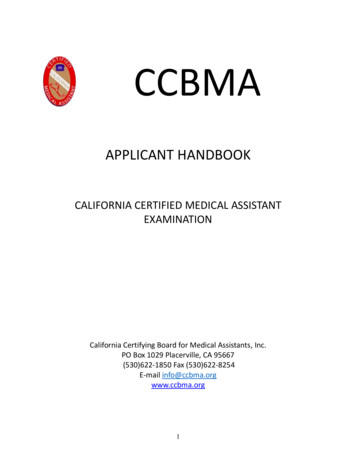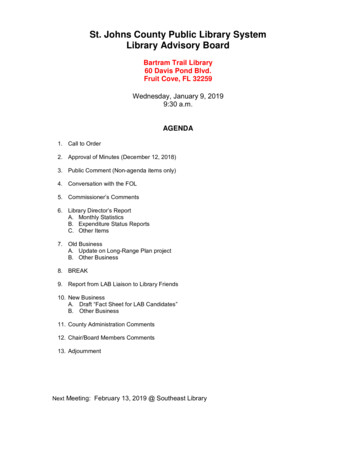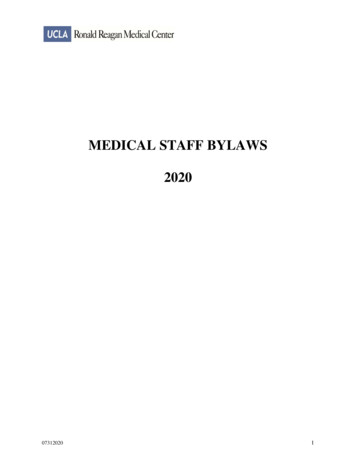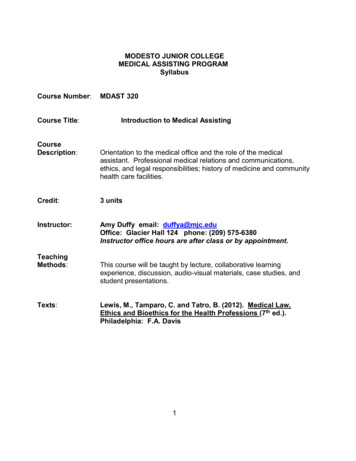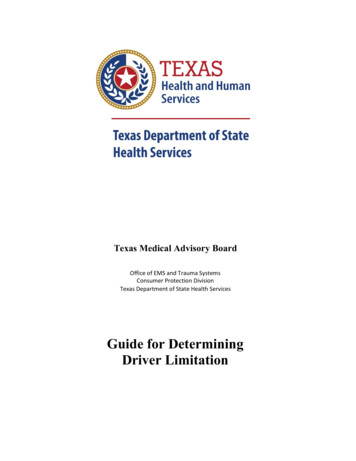
Transcription
Texas Medical Advisory BoardOffice of EMS and Trauma SystemsConsumer Protection DivisionTexas Department of State Health ServicesGuide for DeterminingDriver Limitation
Reviewed 07/23/2021Revised 03/2014
PREFACEThe Texas Medical Advisory Board (MAB) for Driver Licensing was established in 1970 to advisethe Texas Department of Public Safety (DPS) in the licensing of drivers having medical limitations,which might adversely affect driving. See Chapter 12 of the Texas Health and Safety Code, Sections12.092–12.098.Realizing a need for criteria with which to judge the cases consistently and fairly, the MAB membersassembled a set of guidelines. The original set of guidelines was composed of some informationborrowed from the American Medical Association's Physician's Guide for Determining DriverLimitation with input from MAB members. However, further revisions in 2013 were made, utilizingthe expertise of MAB members and other physicians along with a guide, entitled: “Driver FitnessMedical Guidelines” produced in 2009 by the National Highway Traffic Safety Association (NHTSA)and The American Association of Motor Vehicle Administrators (AAMVA) to assist licensingagencies in making decisions about an individual’s fitness for driving. MAB’s current revisedguidelines are entitled: “Guide for Determining Driver Limitations for the Medical Advisory Board”.The ultimate goal is to allow all who can drive safely to do so, and to continue to reduce the numberand severity of motor vehicle accidents in Texas. The Texas Transportation Code, Chapter 521charges DPS with the responsibility of determining if applicants or licensees should or should not belicensed when a medical condition exists that could possibly affect their ability to drive. There areseveral types of examinations that can legally be required as part of the medical review and licensingprocess to help make the determination - one of which is a complete medical examination.The Medical Advisory Board operates solely in an advisory capacity and DPS relies heavily on theirprofessional advice, and has the final responsibility for licensure.No individual is permitted to appear personally before the Medical Advisory Board. The MABreviews medical facts provided by the licensee’s attending physician and sometimes other relevantevidence. MAB member physicians utilize their expertise and accumulated years of experience alongwith its MAB guidelines in reaching an opinion. MAB meets every other week to review cases. Aftercompletion of its reviews, the MAB makes a written recommendation for each case reviewed which isforwarded to the DPS Driver License Division. After receiving MAB’s opinion, DPS notifies theindividual by mail of its decision concerning licensure. This takes approximately two (2) weeks fromthe time it receives the MAB recommendation.As the driver licensing agency for Texas, DPS is solely responsible for all actions taken or initiated.Neither the Medical Advisory Board nor the attending physicians are legally liable for the decisions oractions taken by DPS in the suspension, revocation or denial of driver licenses. The DPS decisionmay be appealed to the courts for final determination.Reviewed 07/23/2021Revised 03/2014
Reviewed 07/23/2021Revised 03/2014
Special Thanks and Acknowledgement to All The Physicians That Helped Create ThisGuideSara Austin, M.D.Steven Tynes, M.D.Neurology, Neuromuscular diseaseA Special Thanks for coordinating the revisions2013Physical Med. & Rehabilitation, Sports Medicine Rehab MedBoard MemberRobert Fayle, M.D.Neurology, Sleep MedicineRevision CommitteeJacqueline Phillips-Sabol, PhD, ABCNNeuropsychology, DementiaRevision CommitteeJonathan Larson, M.D.Emergency MedicineBoard MemberRyan Butler, O.D.OptometristBoard MemberAlexander Ely, M.D.Emergency MedicineBoard MemberJim Kelaher, M.D.Occupational Medicine, Internal MedicineBoard MemberJames V. Kemper, MDENT, OtologyRevision CommitteeRonald DeVere, M.D.Neurology, DementiaRevision CommitteeJohn McCormick, O.D.OptometristBoard MemberCardiovascular Diseases, CardiacElectrophysiologyThomas Coopwood, M.D.General Surgery, Critical CareBoard MemberBernard Patten, M.D.NeurologyBoard MemberLee Arnold, M.D.Family PracticeBoard MemberNeil Grieshop, M.D.General SurgeryBoard MemberLawrence Buxton, M.D.NeurologyBoard MemberJohn Anil Lincoln, MD, PhDNeurology, Multiple SclerosisRevision CommitteeMatthew Phillips MDCardiologyRevision CommitteeJeremy D. Slater, MDReviewed 07/23/2021Revised 03/2014David Tschopp, M.D.Revision CommitteeNeurology, EpilepsyRevision Committee
Paul E. Schulz M.DNeurology, DementiaRevision CommitteeGlen Journeay, M.D. editingFamily PracticeBoard MemberAlison Leston M.D.NeurologyBoard MemberMaria E Arizmendez M.D.Physical MedicineBoard MemberSteven Croft M.D.NeurologyBoard MemberMalvin Driver M.D.OpthamologyBoard MemberShobana Murugan M.DAnesthesiologyBoard MemberRobert Van Boven M.D.Cognitive NeurologyBoard MemberLeanne Burnett M.D.NeurologyBoard MemberDr. Nicolo Geralde M.D.NeonatologyBoard MemberWilliam LaValley M.D.Internal MedicineBoard MemberWilliam Pollan D.OOccupational MedicineBoard MemberJudson Smith M.D.OphthalmologyBoard MemberDavid Tasker M.D.OphthalmologyBoard MemberReviewed 07/23/2021Revised 03/2014Michael Stones M.D.Family MedicineBoard Member
Reviewed 07/23/2021Revised 03/2014
TABLE OF CONTENTSFUNCTIONAL ABILITY PROFILES . 1DRIVER CLASSIFICATION . 2GENERAL DEBILITY . 3AGING . 3PULMONARY DISEASES . 3Pulmonary Conditions – Table 1. 3MALIGNANCIES . 4CARDIOVASCULAR DISEASE . 5FUNCTIONAL CAPACITIES .5THERAPEUTIC CAPACITIES .5ANGINA PECTORIS .5HEART FAILURE .5ATHEROSCLEROTIC CARDIOVASCULAR DISEASE . 6MYOCARDIAL INFARCTION (MI) . 6CORONARY ARTERY BYPASS GRAFTING (CABG) . 6PERCUTANEOUS CORONARY INTERVENTION . 6NEW YORK HEART ASSOCIATION CLASS (NYAH)I-II . 6NEW YORK HEART ASSOCIATION CLASS III OR IV. 6MALIGNANT HYPERTENSION . 7SYNCOPE . 7UNEXPLAINED SYNCOPE . 7NEUROCARDIOGENIC SYNCOPE (VASOVAGAL SYNCOPE) . 7RECURRENT UNCONTROLLED SYNCOPE DUE TO ANYTHING OTHER THAN VASOVAGALATTACKS. 7SYNCOPE DUE TO BRADYARRHYTHMIA . 7SYNCOPE DUE TO TACHYARRHYTHMIAS . 7CARDIAC DYSRHYTHMIAS . 7PREMATURE ATRIAL CONTRACTIONS AND PREMATURE VENTRICULAR CONTRACTIONS . 7ATRIAL FIBRILLATION OR ATRIAL FLUTTER. 7ATRIAL VENTRICULAR NODAL RE-ENTRY TACHYCARDIA . 7VENTRICULAR TACHYCARDIA . 8HEART BLOCK . 8CARDIAC PACEMAKERS. 8AUTOMATIC IMPLANTABLE CARDIO-DEFIBRILLATOR (AICD) . 8VENOUS THROMBOEMBOLIC DISEASE . 8ACUTE DEEP VEIN THROMBOSIS (DVT) . 8CHRONIC DEEP VEIN THROMBOSIS . 9Blackout Guidelines . 9NEUROLOGICALDISORDERS . 10RECURRENT TRANSIENT CEREBRAL ISCHEMIC ATTACKS . 10CEREBROVASCULAR ACCIDENT . 10CONVULSIVE DISORDERS . 11Seizure - Table 2. 11DEMENTIA . 12Dementia - Table 3 . 13Reviewed 07/23/2021Revised 03/2014
THE CLINICAL DEMENTIA RATING SCALE (see below for instructions on how to score this test).14HEAD INJURY . 15Head Injury - Table 4 . 15MOVEMENT DISORDERS . 16Parkinson’s - Table 5 . 17MULTIPLE SCLEROSIS. 17EXCESSIVE DROWSINESS (ED). 18Excessive Sleeping - Table 6 . 18NARCOLEPSY . 19PERIPHERAL NEUROPATHY . 19VERTIGO AND DIZZINESS . 19Vertigo - Table 7 . 20PSYCHIATRIC DISORDERS . 21PERSONALITY DISORDERS . 21PSYCHOTIC DISORDERS . 21PSYCHOTROPIC DRUGS . 21POST-TRAUMATIC STRESS DISORDER . 21HOMICIDAL AND SUICIDAL MANIFESTATIONS . 22INTELLECTUAL DISABILITIES . 22Psychiatric Disorders - Table 8 . 22EXCESSIVE ALCOHOL USE AND/OR ABUSE . 24Alcohol Use and/or abuse - Table 9 . 24DRUG USE AND/OR ABUSE . 26Drug Use and/or abuse - Table 10 . 26METABOLIC DISEASES . 28CHRONIC RENAL FAILURE. 28DIABETES MELLITUS . 28Metabolic - Table 11a and 11b . 29MUSCULOSKELETAL DEFECTS . 32ARTHRITIS . 32BACK PAIN . 32CEREBRAL PALSY . 32CERVICAL SPINE DISORDERS . 32HEMIPLEGIA. 32MUSCLE DYSTROPHIES . 32Musculoskeletal - Table 12 . 33EYE DEFECTS . 34VISUAL STANDARDS FOR DRIVER LICENSING . 35DOUBLE VISION – Table 13 . 35PERIPHERAL VISION – Table 14. 36VISUAL ACUITY – Table 15. 37VISUAL ACUITY FOOTNOTES: . 38GLOSSARY . 39ACRONYMS. 43Reviewed 07/23/2021Revised 03/2014
FUNCTIONAL ABILITY PROFILESFunctional ability to operate a vehicle safely may be affected by a wide range of physical,mental or emotional impairments. To simplify reporting and to make possible acomparison of relative risks and limitations, the Medical Advisory Board has developedFunctional Ability Profiles for ten categories and seven subcategories, with multiplelevels under each profile. These categories and subcategories are listed in Tables 1-15.Each profile follows the same format:1. No diagnosed condition. This section is used for a patient who has indicatedto the Department of Public Safety a problem for which no evidence is found,or for which no ongoing condition can be identified. For example, thiscategory might apply to a person with a heart murmur as a young child whoindicates heart trouble, or to a teenager who fainted in gym class once on a hotday who indicates blackouts.2. Condition. Fully recovered/compensated. This category indicates a history ofa condition which has been resolved or which does not warrant review.Guidance for the use of this section is given in each profile3. Active impairmenta. Minimal. This section may call for a periodic review because of anongoing condition which could deteriorate.b. Mild. This section deals with conditions which may impair driving butwhich are controlled so that a person can still operate a motor vehiclesafely. Reviews are more frequent than in (a).c. Moderate. This section identifies impairment which often precludesdriving, but for which there is the potential for recovery to the point ofallowing safe operation of a motor vehicle.d. Severe. This section identifies permanent conditions with little or nopotential for improvement and which precludes safe operation of amotor vehicle.4. Condition under investigation. This section is for newly identifiedconditions. Follow-up reports will place condition in its proper part of section3.In all cases, periodic reviews may place the driver being evaluated in a higher or lowersection as the condition improves or deteriorates.Note to Physicians:Completion of the medical forms by the physician is a great service to the patient, in thatit may help the patient retain their ability to drive their vehicle; it is also a great service tothe people of Texas in helping to remove unsafe drivers who might endanger lives andproperty.Physician comments can be of benefit in making a proper determination, and should bemade with consideration of the patient's ability to drive in a safe and responsible manner.Please complete the forms for the specific medical problem and do not just mark does notapply to all questions. Specific information of the medical problem is needed.Reviewed 07/23/2021Revised 03/20141
DRIVER CLASSIFICATIONThe holder of a valid driver's license may drive all vehicles in the class for which that license isissued, and all lesser classes of vehicles except motorcycles and mopeds.A Commercial driver's license is required for operation of vehicles used to transportpassengers or property if the motor vehicle:(1) Has a gross combination weight rating of 26,001 or more pounds inclusive of atowed unit with a gross vehicle weight rating of more than 10,000 pounds;(2) Has a gross vehicle weight rating of 26,001 or more pounds;(3) Is designed to transport 16 or more passengers, including the driver; or(4) Is transporting hazardous materials and is required to be placarded in accordancewith 49 C. F. R. Part 172, Subpart F.Class A: Permits a person to drive any vehicle or combination of vehicles with a grosscombination weigh t rating of 26,001 pounds or more, provided the gross vehicleweight rating of the vehicle(s) being towed is in excess of 10,000 pounds.Class B: Permits a person to drive:(1) A single vehicle with a gross vehicle weight rating of 26,001 pounds or more, andany such vehicle towing either a vehicle with a gross vehicle weight rating thatdoes not exceed 10,000 pounds or a farm trailer with a gross vehicle weight ratingthat does not exceed 20,000 pounds; and(2) A bus with a seating capacity of 24 passengers or more, including the driver.Class C: Permits a person to drive:(1) A single vehicle with a gross vehicle weight rating of less than 26,001 pounds, orany such vehicle towing either a vehicle with a gross vehicle weight rating thatdoes not exceed 10,000 pounds or a farm trailer with a gross vehicle weight ratingthat does not exceed 20,000 pounds; and(2) A bus with a seating capacity of less than 24 passengers, including the driver.Class M: Permits operation of a motorcycle or moped subject to applicable restrictions.Reviewed 07/23/2021Revised 03/20142
GENERAL DEBILITYAGING: The quality of life for the aging can be greatly affected by their mode of transportation.Attempts should be made to preserve for this group the privilege of driving as long as the dangerto themselves and others is no greater than that of the general driving population.Because the aging process cannot be measured chronologically, the opinion of the treatingphysician regarding the applicant's functional capacity cannot be overestimated. This is aresponsibility which the treating physician should not neglect. In some cases it might be feasibleto suggest a period of restricted driving before the license is removed. It should be rememberedthat aging accounts for the most important organic factors contributing to driving problems.Information to be considered in licensing this group of drivers includes: general weakness;organic brain syndrome causing memory loss; slowed reaction time; confusion or psychoses;musculoskeletal disabilities; and loss of visual acuity and peripheral fields. Requiringcomprehensive written and driving tests can produce results which will determine whether alicense should be issued and whether or not it should be restricted. Frequent reevaluations areadvisable at yearly intervals or more often if indicated.PULMONARY DISEASES: To be considered are such diseases as emphysema, bronchitis andasthma. In advanced stages any one or a combination of these could produce dyspnea andsyncope, thus limiting the applicant's capacity to drive safely.Most patients with chronic pulmonary diseases of various etiologies will have no difficultymaintaining their driving privilege. Two pulmonary disorders which deserve special attention areChronic Obstructive Pulmonary Disease (COPD) and Sleep Apnea (discussed elsewhere in thismanual).Those individuals suffering from COPD with dyspnea on exertion or at rest should be evaluated.As a guideline, the oxygen saturation should be measured to determine their oxygen-carryingcapacity. Those using supplemental oxygen would also fall into this category.Evaluation of the driver should take place after optimal medical treatment.Pulmonary Conditions – Table 1ProfileCircumstances*Levels1.No diagnosed conditionCondition ExampleNo known disorder2.Condition fully recovered Restrictive, tonic, infectious,Bronchospastic or obstructiveor compensatedlung disease, recovered3.Active impairment:a. Minimalb. MildReviewed 07/23/2021Revised 03/2014a. Pulmonary disease withepisodic symptoms, controlledwith medication.b. Mild-moderate dyspnea onexertion, no dyspnea at rest.Oxygen saturation 88% withexertion.3Interval forReviewN/Aa. N/Ab. 24 monthsreview
c. Moderatec. Moderate-severe dyspnea onexertion, no dyspnea at rest, 0saturation 88% usingsupplemental oxygen.c. 12 monthsreviewd. Severed. Same as (c), Cannotmaintain 0 saturation 88%with or without oxygen.d. No drivingCondition underNewly discovered pulmonaryinvestigationdisorder*For further explanation, refer to page 14.As neededMALIGNANCIES: Malignancies involving the central nervous system or other vital organsystems, when causing general debility or disturbance of judgment or consciousness, should be acontraindication to the operation of any motor vehicle. The determination should be made on anindividual basis with a Comprehensive Driving Test.Reviewed 07/23/2021Revised 03/20144
CARDIOVASCULAR DISEASEThe degree of limitation caused by an applicant’s cardiovascular status should be noted utilizingthe American Heart Association’s functional and therapeutic classification.FUNCTIONAL CAPACITIES:Class I:Class II:Class III:Class IV:No symptoms - no limitations to private, cargo transport vehicles, or passengertransport vehicles in classes A, B & C.Symptoms with strenuous activity – no limitations to private or cargo transportvehicles in classes A, B & C; precludes passenger transport vehicles in classes A,B & C.Symptoms with normal activity – consider restrictions to private vehicles in classC; precludes cargo transport and passenger transport vehicles in classes A, B andC.Symptoms at rest – precludes private, cargo transport and passenger transportvehicles in classes A, B and C.THERAPEUTIC CAPACITIES:Class A: No restrictionsClass B:Restricted from strenuous activitiesClass C:Slight restriction of normal activityClass D: Severe restriction of activityClass E:Complete bed restAngina pectoris should be characterized by the Canadian Cardiovascular Society classificationand heart failure by the New York Heart Association classification as outlined below.ANGINA PECTORIS:Class 0:Class 1:Class 2:Class 3:Class 4:AsymptomaticAngina with strenuous exerciseAngina with moderate exertionAngina with mild exertion1. Walking 1-2 level blocks at normal pace2. Climbing 1 flight of stairs at normal paceAngina at any level of physical exertionHEART FAILURE:Class I (mild):No limitation of physical activity. Ordinary physical activity does notcause undue fatigue, palpitation or dyspnea (shortness of breath).Class II (mild):Slight limitation of physical activity. Comfortable at rest but ordinaryphysical activity results in fatigue, palpitation or dyspnea.Class III (moderate): Marked limitation of physical activity. Comfortable at rest but less thanordinary activity causes fatigue, palpitation or dyspnea.Class IV (severe):Unable to carry out any physical activity without discomfort. Symptoms orcardiac insufficiency at rest. If any physical activity is undertaken,discomfort is increased.Reviewed 07/23/2021Revised 03/20145
ATHEROSCLEROTIC CARDIOVASCULAR DISEASE is a common disorder in which aninflammatory process of the arterial system results in aneurysms or obstructive lesionsparticularly involving the coronary arteries. All patients with atherosclerotic cardiovasculardisease should receive optimum medical management and control of cardiovascular risk factors.Evaluation of driving limitation is dependent on severity and control of symptoms. Please refer tothe section dealing with functional class Completion of Stage II ( 6 Metabolic Equivalent ofTask (METS)) of the standard Bruce protocol is sufficient to demonstrate a commercialdriver’s capacity to perform job-related tasks.ANGINA PECTORIS Patients without angina on optimal medical therapy have no restrictions.Patients with angina pectoris controlled to Canadian Cardiovascular Association (CCA) ClassI to II are not restricted in driving. CCA Classification III angina pectoris precludes a classA or B license. A class C license is permitted with the “C” daytime only, “D” not to exceed45 mph and “E” no expressway driving restrictions. CCA Classification IV an
Internal Medicine Board Member . William Pollan D.O Occupational Medicine Board Member . Judson Smith M.D. Ophthalmology Board Member . Michael Stones M.D. Family Medicine . apply to all questions. Specific information of the medical



